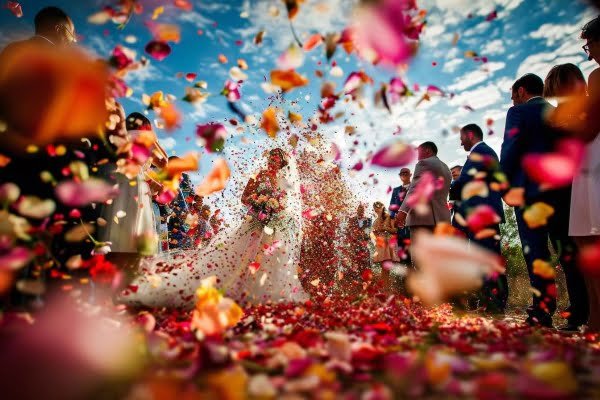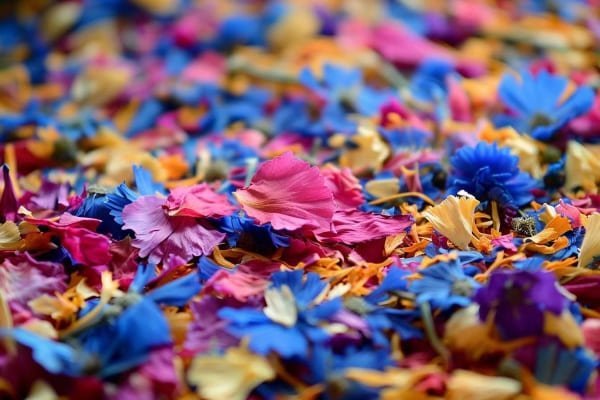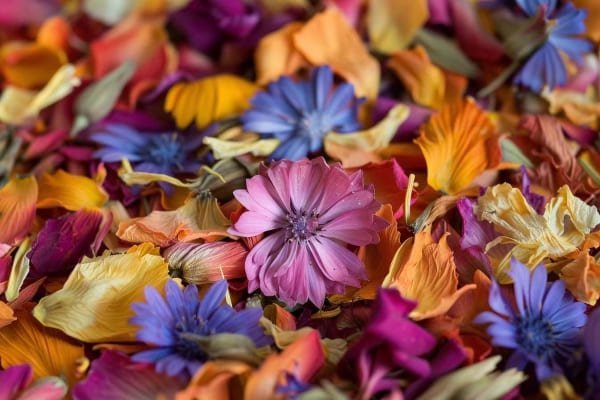When planning a wedding, many couples are becoming more conscious of their environmental impact and are looking for sustainable ways to celebrate. Traditional confetti, often made from plastic or metallic materials, can harm the environment by contributing to litter and taking years to decompose. Eco-friendly wedding confetti alternatives offer a beautiful and sustainable solution that aligns with modern values of environmental responsibility. This guide explores various eco-friendly confetti options, their benefits, and how to incorporate them into your wedding.
1. Biodegradable Paper Confetti
Description: Biodegradable paper confetti is made from materials that break down naturally in the environment, such as rice paper, tissue paper, or recycled paper. These confetti options come in various shapes, sizes, and colors, making them versatile for any wedding theme.
Benefits:
- Eco-Friendly: Biodegradable paper confetti decomposes quickly, reducing environmental impact.
- Variety: Available in numerous colors and shapes, allowing for customization to match wedding decor.
- Safe for Wildlife: Unlike plastic confetti, biodegradable paper poses no threat to animals and birds.
How to Use:
- Ceremony Exit: Provide guests with cones or packets of biodegradable paper confetti to toss as the couple exits the ceremony.
- Table Decorations: Scatter biodegradable paper confetti on tables for a festive touch that complements the reception decor.
- Photographic Moments: Use during key photographic moments, such as the first kiss or first dance, to add a burst of color to the photos.
2. Dried Flower Petals
Description: Dried flower petals are a natural and beautiful alternative to traditional confetti. They can be sourced from various flowers, such as roses, lavender, or marigolds, and can be either purchased or DIY-ed by drying your own flowers.
Benefits:
- Natural Aesthetic: Dried flower petals add a romantic and organic touch to weddings.
- Fragrant: Many dried flowers, like lavender, add a pleasant fragrance to the celebration.
- Biodegradable: Being natural, they decompose easily, leaving no harmful residue.
How to Use:
- Aisle Decorations: Scatter petals along the aisle for a fragrant and colorful pathway.
- Confetti Toss: Use for the ceremonial exit, creating a picturesque moment as the petals flutter in the air.
- Centerpieces: Incorporate dried petals into table centerpieces or scatter them around candles for added elegance.
3. Seed Paper Confetti
Description: Seed paper confetti is made from biodegradable paper embedded with seeds. When planted, the paper decomposes, and the seeds grow into flowers, herbs, or other plants.
Benefits:
- Sustainable: Seed paper not only decomposes but also promotes new plant growth.
- Memorable Keepsake: Guests can take the confetti home to plant, serving as a living memory of the wedding.
- Versatile: Available in various shapes, colors, and seed types to match wedding themes.
How to Use:
- Guest Favors: Package seed paper confetti in small envelopes or boxes as wedding favors for guests.
- Confetti Toss: Use for the exit toss, with instructions for guests to plant the confetti afterward.
- Decorative Touch: Incorporate into table settings or as part of invitation designs for a cohesive eco-friendly theme.
4. Birdseed Confetti
Description: Birdseed confetti is a mixture of seeds safe for birds to eat. This eco-friendly option ensures that no waste is left behind, as birds will consume the confetti.
Benefits:
- Wildlife-Friendly: Provides food for local birds, contributing to the ecosystem.
- Natural: Made from natural materials, it decomposes easily if not eaten.
- Mess-Free: No need for cleanup as birds will take care of the confetti.
How to Use:
- Outdoor Weddings: Ideal for outdoor ceremonies where birds are present, such as gardens or parks.
- Confetti Cones: Provide guests with cones or sachets of birdseed to toss.
- Reception Decor: Use as part of the table decorations, blending seamlessly with a rustic or garden theme.
5. Leaf Confetti
Description: Leaf confetti is made from small, punched-out pieces of leaves. This natural confetti can be made from various types of leaves, offering a range of colors and textures.
Benefits:
- Completely Natural: Made from leaves, it decomposes naturally without harming the environment.
- Unique Texture: Adds an organic and textured look to wedding decor.
- DIY Option: Easily created by collecting and punching out leaves.
How to Use:
- Nature-Themed Weddings: Perfect for nature-inspired or outdoor weddings.
- Aisle Scatter: Scatter along the aisle or on tables for a natural look.
- Confetti Toss: Use for the exit toss, providing a unique and eco-friendly alternative to traditional confetti.
6. Lavender Buds
Description: Lavender buds are dried flower buds from the lavender plant. They are fragrant and visually appealing, making them a popular choice for eco-friendly confetti.
Benefits:
- Fragrant: Adds a soothing and pleasant aroma to the wedding environment.
- Biodegradable: Naturally decomposes without leaving harmful residues.
- Aesthetic Appeal: The purple hue of lavender buds adds a touch of elegance and romance.
How to Use:
- Aisle Decorations: Scatter lavender buds along the aisle for a fragrant and beautiful pathway.
- Confetti Toss: Use for the ceremonial exit to create a fragrant and photogenic moment.
- Table Decor: Incorporate into table settings, centerpieces, or around candles for added charm.
7. Herb Confetti
Description: Herb confetti is made from dried herbs such as rosemary, thyme, or mint. This type of confetti is aromatic and adds a unique touch to the wedding atmosphere.
Benefits:
- Aromatic: Adds natural fragrances to the celebration, enhancing the sensory experience.
- Biodegradable: Decomposes naturally, leaving no environmental impact.
- Symbolic: Many herbs have symbolic meanings, such as rosemary for remembrance or thyme for courage.
How to Use:
- Rustic Weddings: Perfect for rustic or garden-themed weddings.
- Confetti Toss: Use for the exit toss, adding a fragrant and meaningful touch.
- Table Settings: Scatter herbs on tables or incorporate them into centerpieces for added aroma and texture.
8. Eco-Friendly Glitter Confetti
Description: Eco-friendly glitter confetti is made from biodegradable materials such as plant cellulose. Unlike traditional glitter, it decomposes naturally and is safe for the environment.
Benefits:
- Sparkle and Shine: Adds a touch of glamour and sparkle without harming the environment.
- Biodegradable: Breaks down naturally, reducing environmental impact.
- Variety: Available in various colors and shapes to match wedding themes.
How to Use:
- Photographic Moments: Use during key moments like the first dance to add a sparkling effect.
- Decorative Touch: Scatter on tables or incorporate into invitations for a touch of glamour.
- Confetti Toss: Use for the exit toss, providing a dazzling and eco-friendly alternative.
9. Coconut Flakes
Description: Coconut flakes are a natural and biodegradable option for confetti, adding a unique texture and look to the celebration.
Benefits:
- Natural and Safe: Completely natural and safe for the environment.
- Unique Texture: Adds a distinct and exotic touch to wedding decor.
- Biodegradable: Decomposes naturally, leaving no waste.
How to Use:
- Tropical Weddings: Perfect for beach or tropical-themed weddings.
- Table Decor: Use as part of the table decorations for a unique texture.
- Confetti Toss: Use for the exit toss, providing a natural and distinctive look.
10. Rice Confetti
Description: Traditionally used in weddings, rice confetti is made from uncooked rice grains. Modern couples often opt for organic or colored rice for added visual appeal.
Benefits:
- Symbolic: Rice throwing is a long-standing tradition symbolizing prosperity and fertility.
- Biodegradable: Natural and decomposes easily without harming the environment.
- Safe for Birds: Using organic rice ensures it is safe for birds and wildlife.
How to Use:
- Ceremony Exit: Have guests throw rice as the couple exits the ceremony to uphold tradition.
- Aisle Decorations: Scatter rice along the aisle for a minimalistic, clean look.
- Reception Decor: Incorporate colored rice into table centerpieces for a pop of color.
11. Fabric Confetti
Description: Fabric confetti is made from small pieces of biodegradable fabric, such as cotton or linen. These can be in various colors and shapes, adding a unique touch to the celebration.
Benefits:
- Reusable: Guests can take fabric confetti home as keepsakes or reuse them.
- Soft Texture: Adds a delicate and soft texture to the decor.
- Biodegradable: Breaks down naturally, reducing environmental waste.
How to Use:
- Guest Toss: Provide guests with sachets of fabric confetti for the ceremony exit.
- Table Decor: Scatter on tables or incorporate into centerpieces for a tactile element.
- Wedding Favors: Package in small bags as part of guest favors.
12. Edible Confetti
Description: Edible confetti is made from food items such as dried herbs, spices, or colored sugar. This type of confetti is safe to eat and adds a fun element to the celebration.
Benefits:
- Safe for All: Non-toxic and safe for guests, including children and pets.
- Multi-Purpose: Can be used as both decor and a treat.
- Biodegradable: Edible confetti naturally decomposes, leaving no waste.
How to Use:
- Cake Decorations: Sprinkle on wedding cakes or desserts for an edible touch.
- Guest Toss: Use for the ceremonial exit, ensuring a safe and fun experience.
- Table Settings: Incorporate into table settings for a playful and interactive element.
Practical Considerations for Eco-Friendly Confetti
Budget and Sourcing
- Cost-Effective Options:
- Many eco-friendly confetti options, like dried flower petals or biodegradable paper, are affordable.
- DIY alternatives, such as making your own leaf or herb confetti, can help save costs.
- Sourcing:
- Purchase from eco-conscious vendors who specialize in sustainable wedding supplies.
- Consider local suppliers to reduce the carbon footprint associated with shipping.
DIY Projects
- Dried Flower Petals:
- Collect flowers from your garden or local florist.
- Dry the petals by spreading them out in a single layer in a cool, dark place.
- Leaf Confetti:
- Gather leaves from various trees and plants.
- Use a craft punch to create small shapes from the leaves.
- Seed Paper:
- Make your own seed paper by blending recycled paper with water and adding seeds.
- Spread the mixture thinly on a screen to dry.
Environmental Impact and Benefits
- Reduction of Waste:
- Eco-friendly confetti decomposes naturally, significantly reducing waste compared to traditional options.
- Helps in maintaining the cleanliness and integrity of the wedding venue.
- Wildlife Safety:
- Natural confetti options are safe for birds and animals, preventing harm that traditional plastic confetti can cause.
- Birdseed and rice confetti provide food for wildlife, contributing positively to the ecosystem.
- Promoting Sustainability:
- Choosing eco-friendly confetti reflects a commitment to environmental responsibility.
- Encourages guests to consider sustainable practices in their own lives.
Case Studies and Real-Life Examples
- Rustic Garden Wedding:
- A couple in the UK opted for dried lavender buds for their garden wedding. The lavender complemented their rustic theme and added a delightful fragrance to the ceremony.
- Guests loved the natural touch, and the couple received many compliments on their eco-friendly choice.
- Beachside Celebration:
- For a beach wedding in California, the couple used coconut flakes and biodegradable glitter confetti.
- The coconut flakes added an exotic touch, and the glitter provided the desired sparkle without harming the environment.
- Urban Loft Wedding:
- An urban couple in New York City chose seed paper confetti. Guests were delighted with the idea of planting the confetti and watching it grow into flowers.
- The seed paper not only served as confetti but also as a memorable keepsake for guests.
Incorporating Eco-Friendly Confetti into Your Wedding
Planning and Preparation
- Theme and Color Coordination:
- Select eco-friendly confetti that matches your wedding theme and color scheme.
- Consider the overall aesthetic and how the confetti will complement other decor elements.
- Guest Participation:
- Provide clear instructions to guests on when and how to use the confetti.
- Distribute confetti in personalized cones, sachets, or envelopes for a cohesive look.
- Venue Considerations:
- Ensure the venue permits the use of confetti and check for any specific regulations.
- Plan for cleanup if necessary, although many eco-friendly options require minimal cleanup.
- Personalization:
- Customize the confetti packaging with the couple’s initials, wedding date, or a special message.
- Consider DIY options, such as drying your own flowers or punching out leaf confetti, for a personal touch.
Key Moments for Confetti Use
- Ceremony Exit:
- Create a memorable and photogenic moment as the couple exits the ceremony amidst a shower of eco-friendly confetti.
- First Dance:
- Enhance the romance and magic of the first dance with a burst of confetti, creating a stunning visual effect.
- Bouquet Toss:
- Add confetti to the bouquet toss, symbolizing the spreading of love and good fortune.
- Cake Cutting:
- Highlight the cake cutting with a sprinkle of confetti, adding a festive and celebratory touch.
Conclusion
Eco-friendly wedding confetti alternatives offer a wide range of beautiful, sustainable options that align with modern environmental values. From biodegradable paper and dried flower petals to seed paper and birdseed, these alternatives provide elegant and responsible ways to celebrate. Incorporating eco-friendly confetti into your wedding not only enhances the aesthetic appeal but also demonstrates a commitment to sustainability. By choosing eco-friendly options, you can ensure that your special day leaves a positive and lasting impact on both your guests and the environment.




